The first two episodes of Star Trek Discovery were promising, but showed some growing pains. The third episode still had some of that—whatever the writers were trying to accomplish by having Michael recite Lewis Carroll, I think it’s safe to say that it did not work—but on the whole, it made good on that promise. This was a really satisfying hour of TV.
The “previously on Discovery…” montage ended with Michael getting sentenced to life in prison. The episode proper begins with a smash cut to Michael on a prison transport six months later. The point of this little scene is to show us the utopia’s underbelly: sure, Starfleet is great. But if you go into the Federation’s prisons, you’ll find a bunch of people who are not so nice… and perhaps more alarmingly, you’ll find that the Federation treats its prisoners as chattel, and counts their lives as cheap. Michael’s shuttle is transferring her to a dilithium mine to work as a conscript, replacing the last bunch of convicts who got blown up in an industrial accident.
Michael is in this world, but not of it. She’s got a different-colored jumpsuit. The other convicts call her “Starfleet.” She still has all her Starfleet skills: look at her spouting technobabble like a champ, there, about how “that’s species GS-54, an organism that feeds on electricity.” And when the shuttle is disabled and facing certain destruction, she’s the only one who doesn’t start trying to save her own life. Which means that she sees herself the way the system sees the rest of the convicts: as expendable garbage. But of course then the titular Discovery swoops in with a tractor beam to pull Michael—and incidentally, the other convicts—out of the trash.
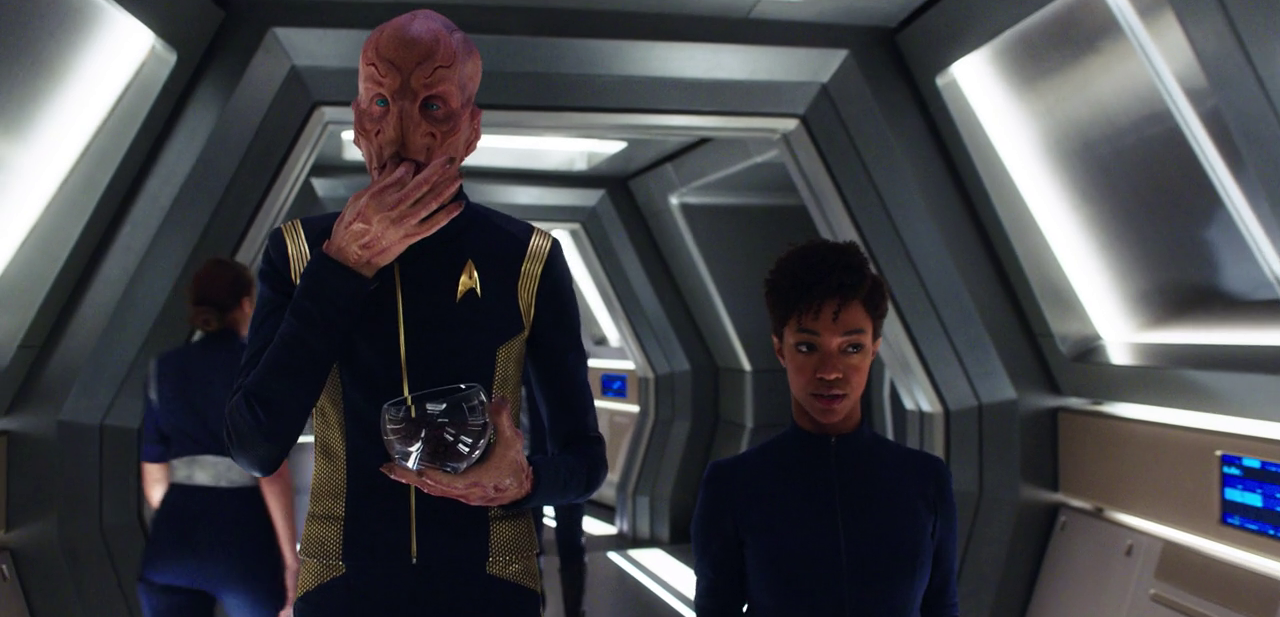
Conveniently enough, most of the non-Yeoh characters that we cared about from the Shenzhou have managed to find new berths on the Discovery. There’s Kayla, aka Commander Shaved-Side, who will probably be important later on (although so far she is less of a character and more of a fashion-forward head trauma). And then there’s Saru. I am very glad that we get to keep Saru, what with his crazy meat-cello of a face, his fussy little glass bowl of blueberries, and especially the fact that Doug Jones is basically just playing him as Niles from Frasier. Saru is both fond and terrified of Michael. He’s not pleased to learn that his captain has assigned this volatile ex-con to provide technical support on the ship’s top-secret military research project. Michael promises Saru that she won’t make trouble.
And then she reneges on this immediately. Like the first day that she’s there, she’s breaking into the ship’s top-secret fungus laboratory, apparently on the grounds that 1) they told her not to and 2) the specific guy who told her not to was kind of a dick.
This characterization feels a little inconsistent. What happened to not causing trouble? What happened to resigning herself to her fate? But I guess they had to burn through a lot of setup really quickly, because we still haven’t gotten to the actual plot of the episode. Here’s that, in a nutshell. The Discovery has a sister ship, the Glenn, which works on the same top-secret science project. By and large, the Glenn was winning, right up until they suffered a critical science failure that horribly killed everyone on board. The Discovery sends an away team to the Glenn to recover any top secret science stuff that’s been left behind. This doesn’t go smoothly: there’s some Klingons on board trying to salvage the same tech, and there’s also a creepy half-seen beast running around killing Klingons and chomping through double-reinforced bulkheads. The away team barely manage to escape with their lives (not including that of the redshirt).
That feels like it could be a standard episode of Trek, right? I’d almost swear that I saw this exact plot play out on TNG or DS9. But there are a few things that Discovery handles differently. For instance, we don’t really get to know what any of the top secret science stuff actually is (at least not yet). This means no back-and-forth between the first officer and the captain over whether this technology is morally acceptable or not. Similarly, the Klingons in the TNG version would probably have a whole act devoted to them, and there’d be some heavy-handed message about rivals becoming allies. Here, they literally show up just long enough for the beast to kill them. On TNG, you’d definitely find out where the beast came from, right? Here they’re like “no time for that, we got what we came for now bomb it from orbit.” (I mean, obviously it has something to do with the research that they were doing on the Glenn, but that’s hardly an explanation. We need at least two paragraphs of technobabble explaining exactly how the experiment spun out of control.)
Why strip the story down like this? Well, it’s partially because they need to make room for all the exposition. But the show also devotes a lot of time to a… well, a sort of melodramatic streak that runs through it. Not melodramatic in the sense of hammy acting. That would NOT separate this from regular Trek. But melodramatic in the sense that some of the character conflicts, and some of the ideological messages, are never stated outright—instead, they’re sort of worked out non-explicitly through the show’s visual rhetoric.
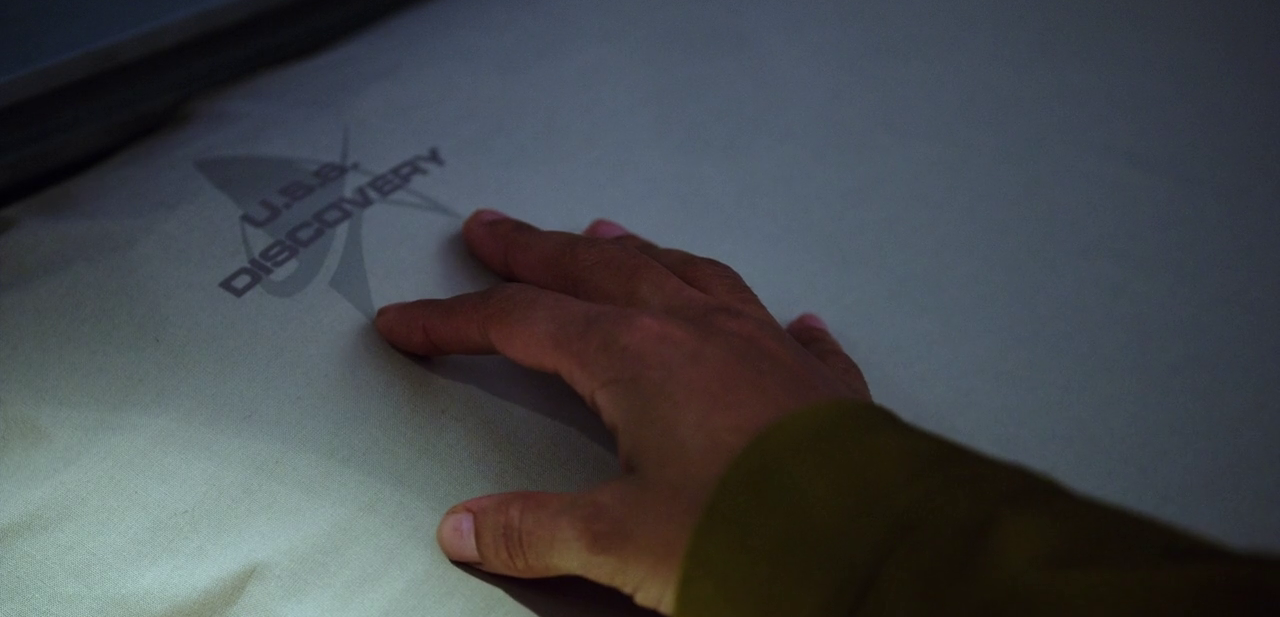
A great example is the scene where Michael walks into her new room and touches the Starfleet logo on her pillow. The show makes this something sensuous. Her finger lingers on the cheap looking fabric. This isn’t hard to decode: of course Michael would have some complex, embodied feelings about getting to sleep on Starfleet sheets again. But if earlier Trek shows wanted to explore these feelings, they would have done it verbally, with a nice little Avery Brooks monologue about the importance of thread count. Here, you just get Michael’s hand tracing the logo on her pillow. That strikes me as fundamentally different. Discovery doesn’t want Michael to read us a report on her feelings: it wants us to feel the things that she feels.
Other things are less tied to character, but still striking and time consuming (and still pretty un-Trek). Take the through-line about different levels of shadow and light. So the new captain, Gabriel Lorca, has an eye condition that means he can’t adjust to different lighting conditions quickly. If he stares into the inky void of space all day, this means he also needs to keep his room dimly lit. A couple of scenes later, Michael is trying to rest in her room—and suddenly her roommate walks in and raises the lights to high immediately. On its own this is a nice little lesson about who can and cannot choose how bright their rooms are. But it keeps on going. When Michael is breaking into the engineering lab, you see her skulking around the dimly-lit ship at night, but then when she steps into the lab it’s lit like it’s day. A few scenes later, on the derelict ship, we indulge in some X-Files style halogen-flashlight-in-a-dark-room chiaroscuro. And then right near the end we have this cool shot of Lorca walking up to a field of unbroken solid black…
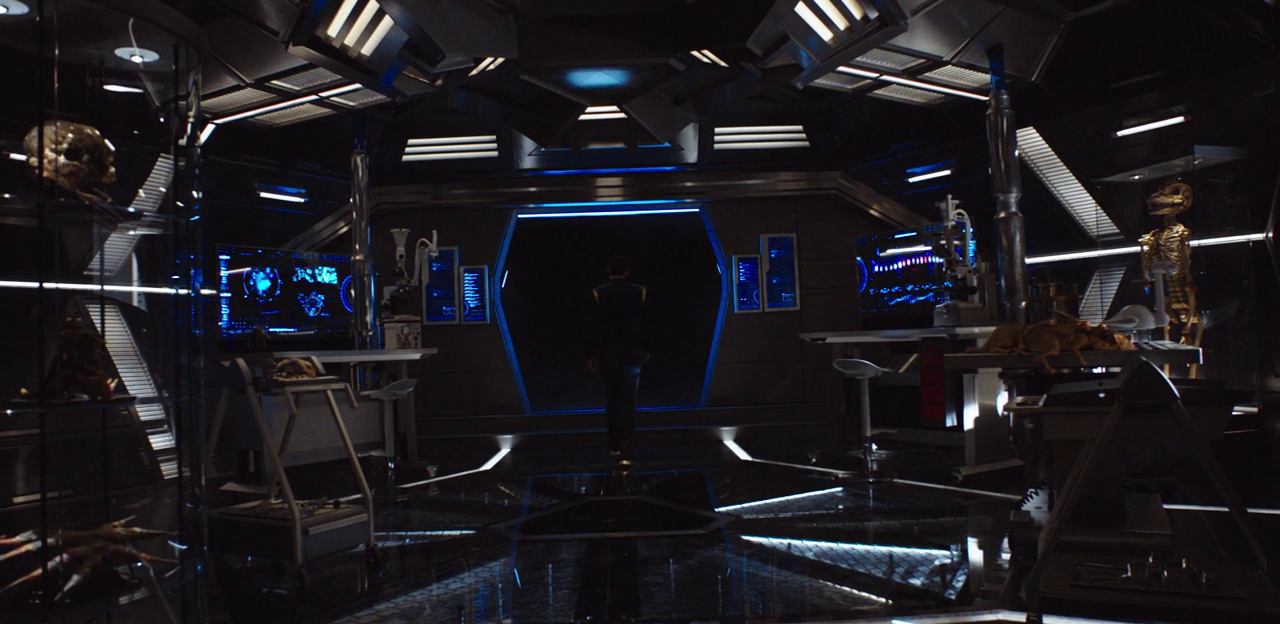
…which is doubly interesting because, in the scene at the end where he’s convincing Michael to stay on the crew, he does it by putting her in a little box that he floods with light. You will never convince me that this was not done on purpose.
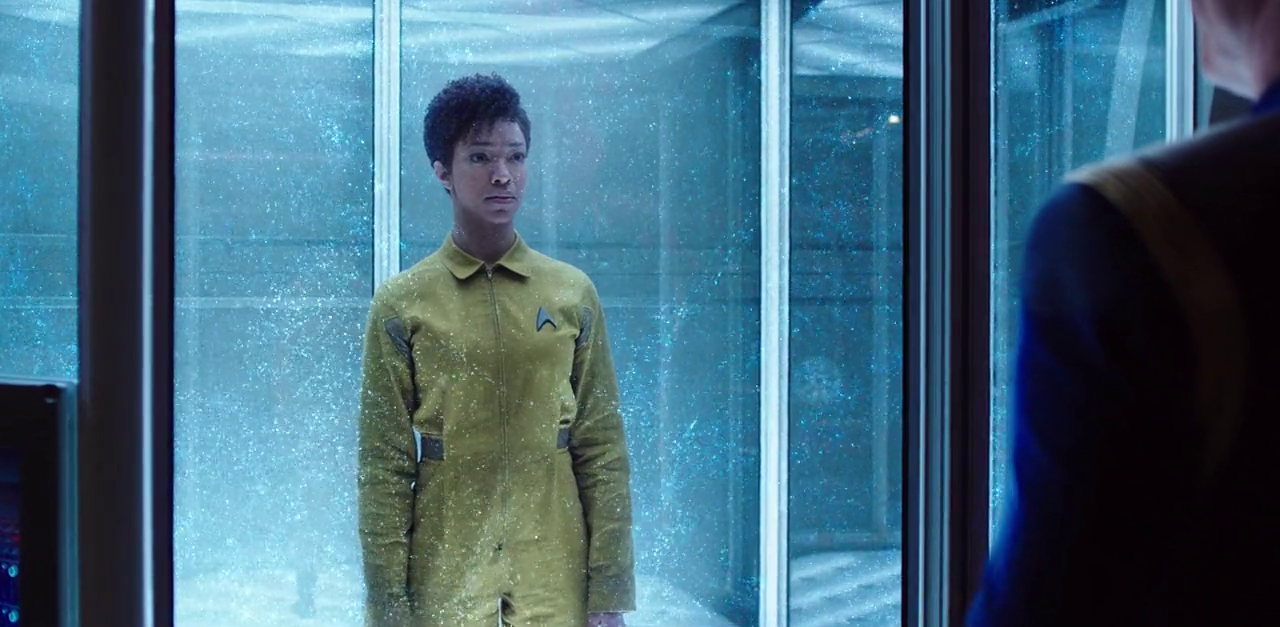
And it has something to do with the core intellectual idea that this episode is circling around, which has to do with the nature of the military-industrial complex. A normal Trek show would have had Picard and Riker laying out the argument explicitly, of course, but here we have to do a lot of the legwork. Here’s how I see it.
The most important speech in the episode is given to Commander Stametz, the astromycologist turned Engineering head. A former research scientist, Stametz was dragooned into service by Starfleet because his research had military potential: “not to further Starfleet’s mission statement of diplomacy and exploration, but for war.” Stametz does not like this. He calls Captain Lorca a warmonger, and distrusts Michael not because she’s a mutineer but simply because Lorca wanted her involved. If Lorca wants her there, she’s a creature of war, and cannot be trusted.
Michael is not really that kind of creature, though, which is why she initially turns down Lorca’s offer of a permanent berth on the Discovery. She thinks he’s involved in biological weapons research, and wants no part in that. But Lorca convinces her that his project is not so sinister, offering a kinder, gentler vision of the military-industrial complex. Stametz’s technology is just a new form of propulsion. It’ll still end up killing hella Klingons, of course, but only indirectly… and think of the commercial possibilities!
And of course, the military-industrial complex can sort of work like this, in small doses. Like, say you’re a beverage scientist. Since you were a little child, you always dreamed of inventing a groundbreaking new beverage technology. But then one day the government calls you up: they want to fund your research. “It’s nothing sinister,” they tell you. “Yes, technically this is part of the war effort. There is a conceivable world where the refreshing materiel that you create will end up giving an American GI the edge that he needs to kill a whole boatload of Russians. But how can anyone hold you culpable for a beverage? Plus, every breakthrough that you make will eventually feed back into pure science.” And so you swallow your misgivings and throw yourself into your research—and sure enough, fifty years later, the cold war is over and we’re all enjoying Tang with every meal.
More cynically minded types—the Michaels, the Stametzes—will tell you that this is a fantasy, not least because it turns out that Tang was not even developed for the space program in the first place. The fantasy version—the light version, if you will—is the version that Lorca sells Michael on in his glowing box. But there’s a darker possibility too. The government agent who calls you up might say “Tell me: could Tang be made… poisonous?” And of course you don’t always get a warning in advance. This is the thing that would keep me up at night, if I was a scientist and the military was putting money anywhere in the general vicinity of my research.
And this is the version on display at the end of the episode, when Lorca walks up to that inky portal. Inside, behind force screens, is the monster from the Glenn, which Lorca had beamed aboard before they blew up the ship. Turns out he is interested in weaponizing Stametz’s research after all. And I suspect that’s because, for Lorca, the idea of commercial applications after the war rests on a faulty assumption that there’s ever going to be an “after the war.” When he looks out into space, he sees only darkness… his eyes won’t adjust to the light.
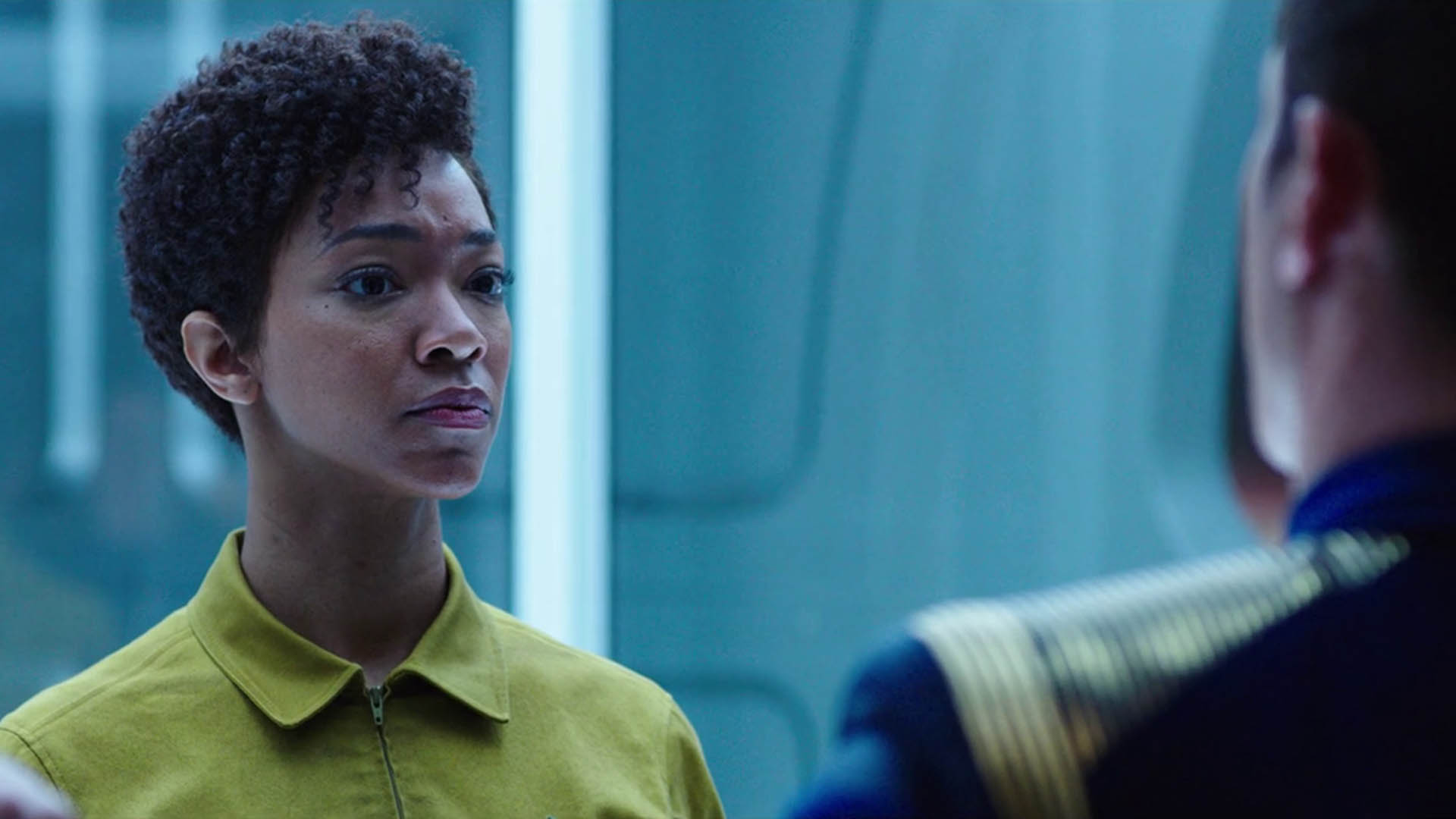
A few thoughts and nitpicks:
– My Federation does not include forced labour, even from prisoners convicted of treason. This aspect of the story seems wildly out of character for Star Trek. I understand that this version of Trek is morally darker, but forced prison labour suggests they’ve thrown the baby out with the bathwater. Even Battlestar Galactica wrestled with the morality of forcing prisoners to do dangerous manual labour, and that show had nowhere near the optimistic, humanistic pedigree that Discovery does. It’s like something out of the Mirror Universe, but not my Trek.
And from a narrative perspective, this approach to incarceration makes the seemingly nefarious activities of Lorca and his ship seem less hypocritical, and thus less surprising. A political entity that professes strong beliefs in human rights and dignity, but secretly is carrying out horrific weapons research is good conflict — a morally corrupt organization doing the same research is kind of expected.
– To “well, actually”, the sister starship was the Glenn(presumably in reference to John Glenn).
– I hated the line that Stametz made about playing in a Beatles cover band. That kind of cultural reference feels unnecessarily forced, super-anachronistic, and culturally chauvinistic.
– The writers have generally been good about continuity with prior series, but here they make a weird gaffe — the magic spores transport Michael to a city on”Romulus”, when it is only later (in The Original Series) that the Federation even makes contact with Romulans.
– The less said about Lorca having a tribble, the better. Except Lorca has a goddamned tribble.
So I desperately want to like this show, since it is new Star Trek and the new movies are, on average, disappointing. Therefore, I have a little bit of headcanon that helps me explain away many of the problems. I’ll share it in case it helps anyone.
It’s basically this: The Discovery, Lorca, Burnham et al are the reason Starfleet is the way it is in TOS. In other words, the Discovery will mess things up so bad that Starfleet, right before TOS starts, has to put in a series of policies to try and emphasize its non-military side and prevent any more Lorcas or Burnhams from rising up the ranks.
I first thought of this at the beginning of the first episode when Capt. Gergiou or Burnham (can’t remember which) cite something that sounds a heck of a lot like the Prime Directive but isn’t actually called that. Which means that sometime in the very near future, the Prime Directive will have to get codified as such.
This also sort of explains the uniforms. Maybe the colorful, distinct uniforms were an attempt to look less like an army. And this one has pretty good evidence. After all, Starfleet loves to change uniforms often. The crew of TNG alone went through like five versions of the uniform in like ten years. Not only that, but whenever the Federation is on more war-like footing, the uniforms go from a lot of bright color with dark/neutral accents to dark/neutral with color accents. Throughout most of DS9 after all, they all wear those grey and black numbers with the color turtlenecks underneath. These uniforms were introduced not long after the battles agains the Borg (among other skirmishes). This all probably a coincidence, but it kinda tracks.
A similar and related headcanon is that Sarek’s relationship to his children (biological and adoptive) also stems from the existence of an earlier more militaristic Starfleet that was purposefully counteracted later. It seems like Sarek has a thing for trying to make humans into Vulcans. He marries a human and takes her to live on Vulcan like a Vulcan. He adopts a human and tries to make her Vulcan, more or less at the same time, he pressures, perhaps not intentionally, his half-human son into needing to be completely Vulcan. And yet the two of them join Starfleet, despite his hatred of it (or maybe as a rebellion against the pressures of being what they can never be completely). Why does he have such hatred for this organization? Why does he push Burnham into it, but cut off his relationship when he joins only a year later? In my mind, it’s because he sees the military star-fleet, in all it’s nefariousness, aggressiveness, and expansionary zeal as too human. The Vulcans shot first against the Klingons, after logic led them to realize it was the only way to have peace. The humans of Starfleet, built a bunch of warships, called them “science vessels” and kept saying “we come in peace,” like they were taunting everyone. And once they are provoked, humans are as vicious as the Romulans, but want to be seen as civilized as Vulcans. So, Michael, who let’s be honest, sucks at being Vulcan is “encouraged” to go back to being human. But then, a year later, Spock who Sarek clearly sees as his true heir (Michael and Sybok be damned), also joins. He was a little more ready to see Burnham fail miserably at being Vulcan, but it’s probably harder for him to watch Spock also fail. So, having failed at making his children less human, he might have been influential in making Starfleet more Vulcan. He is after all, a pretty important person on Vulcan, and the Vulcans are one of the four founding members of the Federation. And there’s obviously people who agree with him. Maybe since he can’t get Spock to change his mind about joining Starfleet, his way of trying to “save” Spock, like he couldn’t with his fully-human adoptive sister, is to try and change Starfleet. This theory also explains why neither Sarek or Spock mention Michael, well other than both of them suck at showing affection or being a family. Sarek stopped talking to his son just for joining Starfleet. If Burnham was involved with a ship and a crew that failed so miserably, and probably did some real questionable things int he process, is it any wonder that he’d basically just act like his adoptive daughter didn’t even exist.
Anyway, that’s my pitch on how to watch this show. We are basically watching the crew that messed up so badly, went so far off the rails, that the Federation had to create the Prime Directive and change the course of Starfleet to contain the damage. Everything we see from here on out, the desire to be explorers not soldiers, the idea that Starfleet shouldn’t be a war fleet despite its warships, captains constantly struggling with the balance between principle and pragmatism, the sheer amount of times the Prime Directive gets violated, they are all reactions to the actions of this ship and its crew.
I was thinking much the same thing — not that this particular ship is at fault (although that’s an interesting idea), but that this Starfleet is the shameful past of the TNG Starfleet.
It seems to never that whatever ship or station is the focus of a series is fairly noteworthy. That’s why I think that if Discovery the show is looking at a certain kind of Starfleet, then Discovery the ship is likely the most outstanding or important example in it.
That never in the first sentence there accidentally. Please disregard.
As it happens, practically all food research in the US (and therefore on Earth) is funded by the US military; we are all implicated in the military-alimentary complex. See Anastacia Marx De Salcedo’s The Combat-Ready Kitchen, http://www.worldcat.org/oclc/979987068, for more details.
And it’s darker than that: Saru’s alien hackles raising at the end of the episode indicated to me that everyone on that prisoner shuttle was about to die. So our protagonist will now be on Discovery “off the books.”
While many will say this is Un-Trek, Star Trek has always tackled the issues of the day. In a world with drone warfare allowing murder at the push of a button, a drive system that allows the Discovery to hit anyone, anywhere seems a great way to explore the eternal moral question of how far we are willing to go to win, and who that makes us.
That is a *bleak* take — and a totally plausible one. Dang.
I read it a bit differently. My thought was that Saru’s danger-sense was triggered because the shuttle just left without Burnham on it.
[“This characterization feels a little inconsistent. What happened to not causing trouble? What happened to resigning herself to her fate? “]
Are you kidding me? People don’t change that fast. Not six months – a period in which she was a convict. Get real.
The real problem with the “STAR TREK” franchise as a whole – and I blame Gene Roddenberry for this – is that we’re to believe that the Federation Starfleet IS NOT a military agency. And yet, it behaves like one – including weapons, military ranking and protocol. The whole thing is reeking with hypocrisy. And I wish that one day, the people who handles the franchise as a whole will realize this.